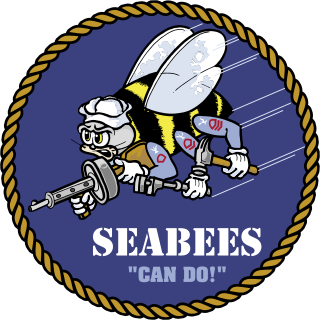
United States Naval Construction Battalions, better known as the Navy Seabees, form the U.S. Naval Construction Forces (NCF). The Seabee nickname is a heterograph of the initial letters "CB" from the words "Construction Battalion". Depending upon context, "Seabee" can refer to all enlisted personnel in the USN's occupational field 7 (OF-7), all personnel in the Naval Construction Force (NCF), or Construction Battalion. Seabees serve both in and outside the NCF. During World War II they were plank-holders of both the Naval Combat Demolition Units and the Underwater Demolition Teams (UDTs). The men in the NCF considered these units to be "Seabee". In addition, Seabees served as elements of Cubs, Lions, Acorns and the United States Marine Corps. They also provided the manpower for the top secret CWS Flame Tank Group. Today the Seabees have many special task assignments starting with Camp David and the Naval Support Unit at the Department of State. Seabees serve under both Commanders of the Naval Surface Forces Atlantic/Pacific fleets as well as on many base Public Works and USN diving commands.

Marine Corps Air Station Futenma or MCAS FutenmaA is a United States Marine Corps base located in Ginowan, Okinawa, Japan, 5 NM northeastB of Naha, on the island of Okinawa. It is home to approximately 3,000 Marines of the 1st Marine Aircraft Wing and other units, and has been a U.S. military airbase since the defeat of the Japanese Imperial Army in the Battle of Okinawa in 1945. Marine Corps pilots and aircrew are assigned to the base for training and providing air support to other land and sea-based Marines in Okinawa and throughout the Asia-Pacific region. MCAS Futenma is part of the Marine Corps Installations Pacific command.

Kadena Air Base is a United States Air Force base in the towns of Kadena and Chatan and the city of Okinawa, in Okinawa Prefecture, Japan. It is often referred to as the "Keystone of the Pacific" because of its highly strategic location. It is located 650 km (400 mi) off the coast of China and at a distance of 770 km (480 mi) from Shanghai, a major economic hub. It is home to the USAF's 18th Wing, the 353rd Special Operations Wing, reconnaissance units, 1st Battalion, 1st Air Defense Artillery Regiment, and a variety of associated units. Over 20,000 American servicemembers, family members, and Japanese employees live or work at Kadena Air Base. It is the largest and most active U.S. Air Force base in East Asia.
Nissan Island Airport is an airfield serving Nissan Island, in the Autonomous Region of Bougainville in Papua New Guinea. It resides at an elevation of 100 feet (30 m) above mean sea level and has a 1,200-metre (3,937 ft) runway designated 14/32.

When World War II broke out the United States Naval Construction Battalions (Seabees) did not exist. The logistics of a two theater war were daunting to conceive. Rear Admiral Moreell completely understood the issues. What needed to be done was build staging bases to take the war to the enemy, across both oceans, and create the construction force to do the work. Naval Construction Battalions were first conceived at Bureau of Yards and Docks (BuDocks) in the 1930s. The onset of hostilities clarified to Radm. Moreell the need for developing advance bases to project American power. The solution: tap the vast pool of skilled labor in the U.S. Put it in uniform to build anything, anywhere under any conditions and get the Marine Corps to train it. The first volunteers came skilled. To obtain these tradesmen, military age was waived to age 50. It was later found that several past 60 had managed to get in. Men were given advanced rank/pay based upon experience making the Seabees the highest paid group in the U.S. military. The first 60 battalions had an average age of 37.
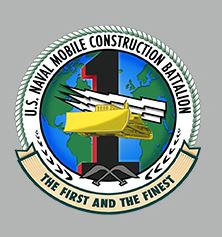
Naval Mobile Construction Battalion 1, is a United States Navy Seabee battalion. NMCB ONE, the original "Pioneers", has a long, proud and distinguished history as the very first Naval Construction Battalion of the service that would become known as the Seabees.
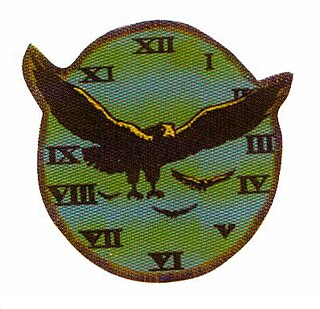
Marine Attack Squadron 543 (VMA-543) was an aviation unit of the United States Marine Corps. The squadron, also known as the "Night Hawks", were part of the Marine Forces Reserve and were based at Naval Air Station Glenview, Illinois until their deactivation on 1 April 1974. Originally activated during World War II, they fought in the Battle of Okinawa as part of the Tactical Air Force. The squadron was credited with downing 15 Japanese aircraft during the war. Following the surrender of Japan, the squadron was deactivated only to be later reactivated as part of the Reserves. They were again deactivated in 1974 and remain in an inactive status today.

Naval Mobile Construction Battalion FORTY, nicknamed Fighting FORTY, was a US Navy Seabee Battalion based out of Port Hueneme, California. Its primary mission was wartime contingency construction as well as peacetime construction and disaster relief.
Emirau Airport is an airfield in Emirau Island, Papua New Guinea.

Naval Mobile Construction Battalion SEVEN (NMCB 7) was a Navy Seabee battalion last homeported at Naval Construction Battalion Center, Gulfport Mississippi. Nicknamed the "Magnificent Seven", it is one of the first ten Naval Construction Battalions formed by the U.S. Navy in 1942.
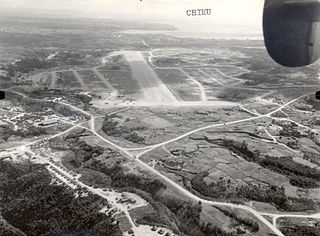
Chimu Airfield or NAB Chimu is a former World War II airfield on the Pacific coast of Okinawa. The airfield was inactivated after October 1945.

Majuro Airfield or Naval Air Facility Majuro (NAF Majuro) is a former World War II airfield on the island of Delap in the Marshall Islands. The facility was supported by a large base, Naval Base Majuro.

Turtle Bay Airfield or Fighter Field #1 is a former World War II airfield on the island of Espiritu Santo in the New Hebrides Islands at the Espiritu Santo Naval Base.
Piva Airfield is a former World War II airfield on Bougainville Island in the Solomon Islands archipelago.

Barakoma Airfield is a former World War II airfield on Vella Lavella in the Solomon Islands archipelago.

Ulithi Civil Airfield is a public airport serving the island of Falalop, located in the Ulithi Atoll in the Caroline Islands, Federated States of Micronesia. It was previously Falalop Airfield or Naval Air Base Ulithi, when used as a World War II airfield.
Marine Air Defense Command 1 (MADC-1) was a United States Marine Corps aviation command and control unit based in Okinawa, Japan. Originally commissioned in April 1944 as Marine Aircraft Group 62 (MAG-62), the higher headquarters for new PBJ squadrons that were training on the east coast of the United States. In late 1944, MAG-62 was tasked with joining the 2nd Marine Aircraft Wing on Okinawa to serve as an additional headquarters element for all of the disparate forces that fell under the command of the Tactical Air Force, Tenth Army. On 15 August 1945, MAG-62 was re-designated as Marine Air Defense Command 1. MADC-1 was a short lived unit that was decommissioned on 30 November 1945, shortly after the surrender of Japan.

The Raid on Yontan was an Empire of Japan military operation carried out on the night of May 24–25, 1945 against Yontan Airfield on Okinawa. The airfield was recently seized by American forces during the first day of the Battle of Okinawa and was being used by United States Marine Corps and Army Air Force squadrons. Five Imperial Japanese Army Mitsubishi Ki-21 bombers, carrying Giretsu Kuteitai special airborne attack troops, conducted a suicide raid against Kadena and Yontan airfields on Okinawa. Four were shot down, but the fifth belly landed on the principal runway at Yontan allowing 10-12 giretsu troops to disembark on the airfield. The raid resulted in the destruction or damaging of 38 American aircraft and 70,000 gallons of fuel. However, its overall value was minimal because Yontan Airfield was reopened at 0800 the following morning with little effect to overall allied aviation operations.
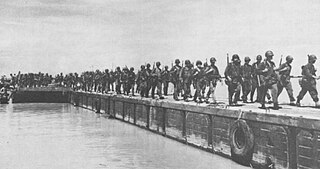
Peleliu Naval Base was a major United States Navy sea and airbase base on Peleliu island, one of sixteen states of Palau. The United States Marine Corps took the island in the Battle of Peleliu during World War II. Battle of Peleliu was a costly conflict that started September 15, 1944, and ended November 27, 1944. On September 30, 1944, Peleliu is declared occupied. The taking of Peleliu and Morotai gave the sea and air protection needed for the later invasion of the Philippines. US Navy Seabee built a number of facilities at Peleliu Naval Base.
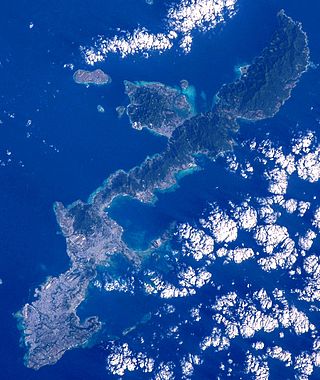
Naval Base Okinawa, now Naval Facility Okinawa, is a number of bases built after the Battle of Okinawa by United States Navy on Okinawa Island, Japan. The naval bases were built to support the landings on Okinawa on April 1, 1945, and the troops fighting on Okinawa. The Navy repaired and did expansion of the airfields on Okinawa. United States Navy Seabees built or repaired the facilities on the island. The bases on Okinawa put the United States Armed Forces only 350 miles from Japan's home islands. Most facilities closed after the war, but some are still in use today by all branches of the United States Armed Forces.

















